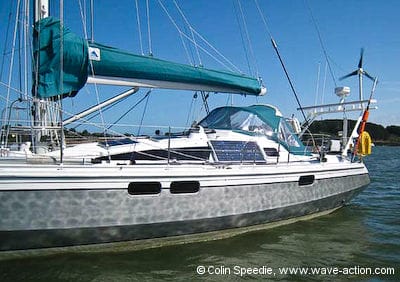Well, we’ve finally moved aboard and are on our way, and although we haven’t travelled very far yet, or even in the direction we had initially planned, it’s a definite relief to be off. This is largely due to the “summer” the South of Britain has been enjoying—certainly the worst in terms of relentlessly poor weather in my memory. And even though it’s early days yet, we have had the chance to evaluate some of the equipment we have chosen for domestic life aboard, as well as the general layout.
After having agonised over the minutiae for so long in the planning stage, it’s been a little nerve wracking waiting to see whether we had got it anywhere near right.

Well, it’s good to report that so far it’s far more good than bad. The interior layout works very well, and the saloon is comfortable and airy with lots of natural light and ventilation. The Webasto heating system (in August!) is excellent, and coupled with the insulation makes the boat cosy and warm even when the temperature drops very low. The only condensation we have seen at all comes from the aluminum inner surrounds of the hatches, which is something we knew we’d have to tackle somewhere down the line, especially as winter nears.
As we have a lot of computer equipment aboard for our work (consultancy and photography), when we are in harbour mode we tend to use a lot of amps. But we were determined not to have a diesel generator or to use the main engine for charging when at rest, so we have tried to maximise power creation from renewable sources, whilst at the same time minimising our consumption. And we’re really impressed with our power generation from a combination of wind and solar at this stage.
We have an articulated solar array of 90 watts mounted on our OVNI arch (what a brilliant structure that is) and we have fitted two 48 watt semi-flexible panels on the deck forward of the dodger. Add to this an 80 watt panel that we bring on deck in harbour and orientate towards the sun, and you have a powerful combination which makes a substantial contribution to our day to day needs. The Superwind generator, whilst not the quietest unit of all, has an amazing output—it’s not been unusual to see 10 to 15 amps output when the wind is fresh, although like most of the larger units it is weak below 8 knots of wind. The upshot of it is that we have never once had to run the engine to charge the batteries at rest—so we’re close to our goal.
The Force Ten cooker that was specially ordered at great expense works well, but seems to suffer from small weaknesses that let it down at times. But the oven is great, the burners are powerful, and once we have ironed out the bugs (mainly to do with a temperamental thermocouple) we think it will give a long life of good service. The only really negative thing to say about is that the supports supplied for the gimbals are far too flimsy. John & Phyllis found the same problem with their stove (see this post), and have very kindly sent me the drawings of the ones they had fabricated as replacements, and these are far more substantial. We’ll definitely replace ours this winter.
All in all, we’re very happy indeed with our new home. We’ve still got a few reservations about the galley layout (linear down the starboard side) once out on the water, but other than that we’ve few complaints, and we’re looking forward to getting some real miles under our belt.
